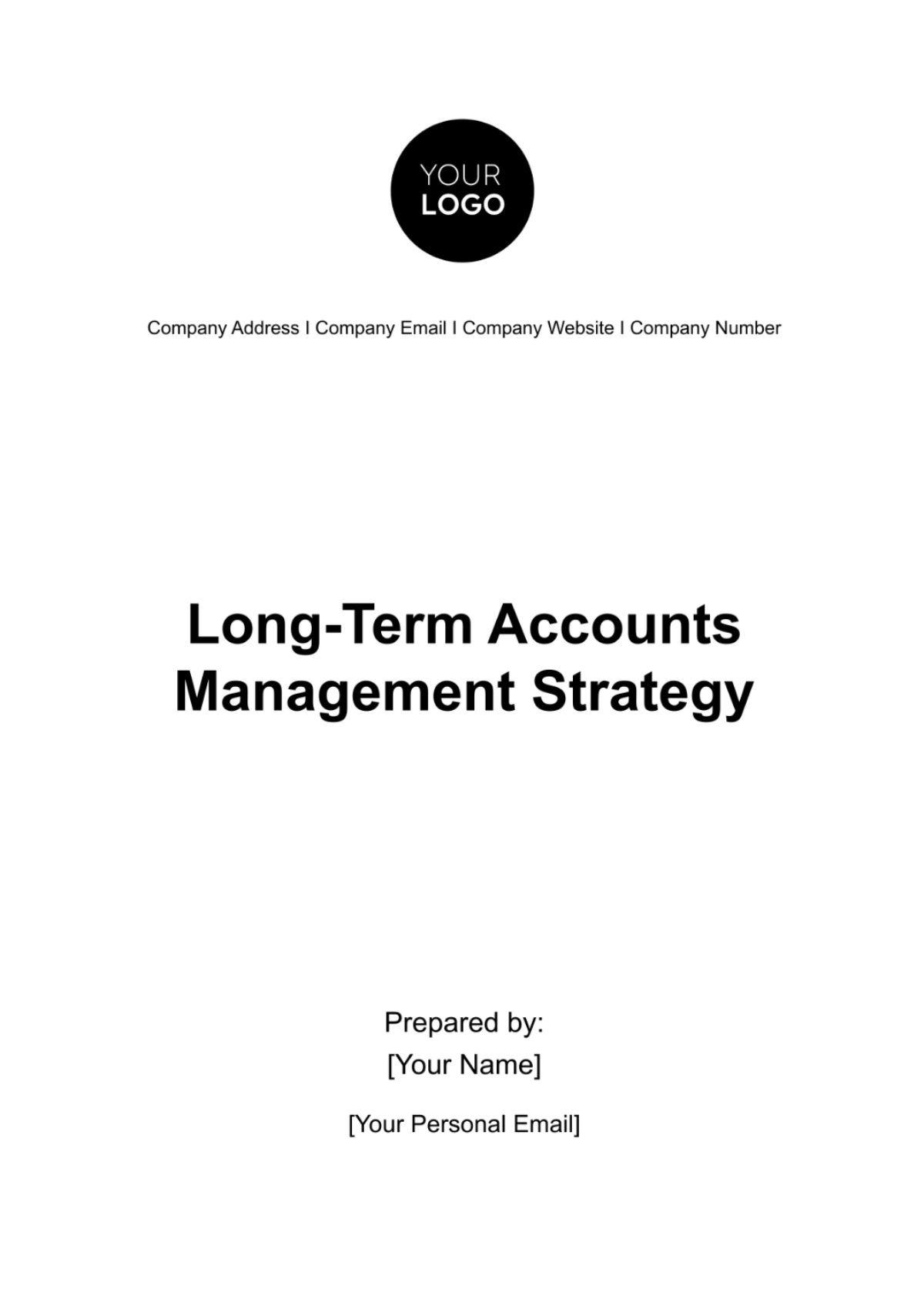Free Long-Term Accounts Management Strategy

Executive Summary
In this comprehensive Long-Term Accounts Management Strategy, [Your Company Name] recognizes the pivotal role of strategic account management in fostering sustained growth and elevating customer satisfaction. Our overarching goal is to cultivate enduring relationships with our diverse clientele, ensuring their needs are met while concurrently driving financial success for our organization. By implementing a multifaceted approach, we anticipate a tangible impact on customer retention, augmented revenue streams, and an overall enhancement of our business performance.
Introduction
In the ever-evolving landscape of modern business, [Your Company Name] acknowledges the fundamental importance of effective accounts management. This document serves as a roadmap, delineating a nuanced and forward-thinking strategy to manage accounts for the long term. We underscore the critical nature of cultivating and nurturing customer relationships as integral to the achievement of our organizational goals. This strategy aligns with our commitment to delivering unparalleled value to our customers while simultaneously fortifying the foundation for our company's sustainable success.
Objectives of Long-Term Accounts Management
The Long-Term Accounts Management Strategy is designed to achieve the following objectives:
Enhance Customer Retention: Aim to increase the customer retention rate by [35%], ensuring sustained loyalty and engagement.
Maximize Annual Revenue: Strategically manage accounts to achieve an annual revenue increase of [$$2,300,000] over the next [3 years].
Improve Operational Efficiency: Streamline account management processes, aiming for a [26%] increase in operational efficiency.
Elevate Customer Satisfaction: Target a Customer Satisfaction Score (CSAT) of [98%], reflecting an unwavering commitment to meeting and exceeding customer expectations.
Stakeholder Analysis
Our analysis of key stakeholders in the Long-Term Accounts Management Strategy underscores the importance of collaboration and communication. Recognizing the interconnected nature of our business relationships, we have identified [Your Partner Company Name], where applicable, as a crucial stakeholder.
By actively involving and aligning with our partners, we aim to enhance the synergy between organizations, fostering mutually beneficial outcomes.
Account Segmentation
In our commitment to strategic account management, a meticulous account segmentation strategy has been implemented. This segmentation is based on specific criteria, allowing us to tailor our approach to the unique characteristics of each segment:
Account Segment | Criteria | Number of Accounts | Annual Revenue |
|---|---|---|---|
Segment 1 | [High Revenue] | [150] | [$5,000,000] |
This strategic segmentation enables us to allocate resources effectively, ensuring that our account management efforts are tailored to the specific needs and expectations of each segment. It provides a foundation for personalized and impactful relationships with our diverse clientele.
Risk Assessment
A comprehensive risk assessment in the Long-Term Accounts Management Strategy has identified potential challenges and uncertainties. Mitigation strategies are crucial to address these risks effectively:
Market Fluctuations: Given market dynamics, a [34%] contingency fund will be allocated to absorb revenue fluctuations.
Technological Risks: Regular updates and security measures will be implemented to mitigate potential disruptions, with a dedicated [Your Company Name] IT team overseeing these efforts.
Competitive Pressures: A proactive approach to market intelligence will be adopted to stay ahead of competitors, allocating [53%] of the budget to strategic market analysis.
Communication Plan
Transparent and effective communication is pivotal in the successful implementation of the Long-Term Accounts Management Strategy:
Internal Communication: Regular team meetings, [Your Company Name] newsletters, and a dedicated communication platform will be utilized to ensure all team members are aligned with the strategy.
External Communication: Quarterly webinars, personalized client newsletters, and social media updates will keep clients informed about new initiatives and improvements.
Performance Metrics
Key performance indicators (KPIs) have been carefully selected to measure the success of the Long-Term Accounts Management Strategy. These metrics will serve as benchmarks for evaluating our progress:
Customer Retention Rate: Targeting an increase to [92%] in customer retention over the next 12 months.
Average Revenue Per Account (ARPA): Aiming for a growth of [$500] in ARPA by implementing value-added services and personalized offerings.
Customer Satisfaction Score (CSAT): Striving for a CSAT score of [90] through continuous feedback collection and enhancements.
These performance metrics align with our overarching objectives, providing quantifiable measures to assess the impact of our account management initiatives.
Training and Development
To empower our account management team, a robust training and development plan has been devised:
Continuous Training Programs: Implementing quarterly training sessions focusing on industry trends, customer relationship management, and effective communication.
Professional Development Opportunities: Allocating [5%] of the budget to support team members in attending relevant conferences and workshops.
Technology Infrastructure
Our commitment to a cutting-edge technology infrastructure is paramount in the Long-Term Accounts Management Strategy:
Customer Relationship Management (CRM) Software: Implementing CRM Software, a state-of-the-art platform designed to enhance customer interactions, streamline data management, and facilitate personalized account management.
Data Analytics Tools: Leveraging advanced analytics tools to derive actionable insights from customer data, enabling data-driven decision-making.
This technology stack ensures that our account management processes are not only efficient but also well-equipped to adapt to the evolving needs of our clients.
Implementation Timeline
A phased implementation approach has been outlined to seamlessly integrate the Long-Term Accounts Management Strategy:
Phase 1 (Months 1-3): | Initiate CRM software implementation, conduct initial team training, and establish baseline performance metrics. |
Phase 2 (Months 4-6): | Roll out communication plan, launch targeted training programs, and begin data analytics tool integration. |
Phase 3 (Months 7-12): | Monitor performance metrics, conduct regular reviews, and implement continuous improvement strategies based on feedback. |
Budget Allocation
The successful execution of the Long-Term Accounts Management Strategy requires a well-considered budget allocation across key components:
Technology Infrastructure: Allocating [$200,000] for the implementation of CRM Software and Analytics Tools, ensuring a robust and efficient technological foundation.
Training and Development: Reserving [$50,000] to support ongoing training programs, workshops, and professional development opportunities for the account management team.
Communication Plan: Deducting [$30,000] for the execution of internal and external communication initiatives, including webinars, newsletters, and social media updates.
Risk Mitigation Fund: Setting aside [$100,000] as a contingency fund to address unforeseen challenges and market fluctuations.
This budget allocation reflects a strategic distribution of resources, optimizing the utilization of funds to achieve the objectives outlined in the Long-Term Accounts Management Strategy.
Vendor Partnerships and Collaborations
In our pursuit of excellence in long-term accounts management, forging strategic partnerships and collaborations with key vendors is a pivotal aspect. This involves a comprehensive approach to assess, integrate, and optimize collaborations for mutual benefit:
Vendor Assessment: Conduct a thorough evaluation of potential vendors, considering factors such as reliability, technological compatibility, and shared values. This ensures that selected vendors align with our long-term accounts management goals and contribute positively to the overall strategy.
Collaborative Initiatives: Develop joint initiatives with selected vendors to enrich our service offerings. By leveraging the expertise and resources of our partners, we aim to provide additional value to our clients, fostering a dynamic and mutually beneficial ecosystem.
Risk Mitigation: Establish a robust risk mitigation plan to address potential challenges associated with vendor partnerships. This includes contingency measures to manage disruptions effectively, ensuring the continuity of operations and service delivery.
Sustainability Integration
In recognition of the growing importance of sustainability in today's business landscape, [Your Company Name] is dedicated to integrating environmentally conscious practices into the fabric of our Long-Term Accounts Management Strategy:
Green Initiatives: Implementing eco-friendly practices within our account management processes, such as digital documentation, energy-efficient technologies, and waste reduction measures. These initiatives not only contribute to a greener environment but also position [Your Company Name] as a responsible corporate entity.
Sustainable Partnerships: Actively seeking collaborations with clients and partners who share our commitment to sustainability. By aligning with like-minded organizations, we aim to create a community of businesses dedicated to environmentally responsible practices.
Measurement Metrics: Developing and monitoring key metrics to quantify the environmental impact of our account management strategies. This includes tracking reductions in carbon footprint, paper usage, and other sustainability benchmarks, with the goal of achieving measurable improvements over time.
Review and Evaluation
A systematic approach to review and evaluation is integral to the Long-Term Accounts Management Strategy:
Frequency: Conducting quarterly reviews to assess the progress of key performance indicators and overall strategy effectiveness.
Feedback Mechanisms: Implementing regular feedback sessions with the account management team, clients, and stakeholders to gather insights for continuous improvement.
Adjustment Strategies: Developing predefined strategies to adjust the approach based on the findings of the reviews, ensuring flexibility and adaptability.
- 100% Customizable, free editor
- Access 1 Million+ Templates, photo’s & graphics
- Download or share as a template
- Click and replace photos, graphics, text, backgrounds
- Resize, crop, AI write & more
- Access advanced editor
Craft a robust financial future with the Long-Term Accounts Management Strategy Template from Template.net. This editable and customizable template offers a strategic framework for managing accounts over the long haul. Tailor it to your unique needs effortlessly using our Ai Editor Tool. Empower your team to navigate financial landscapes with foresight and precision. Secure your financial success with this versatile and user-friendly template.





























